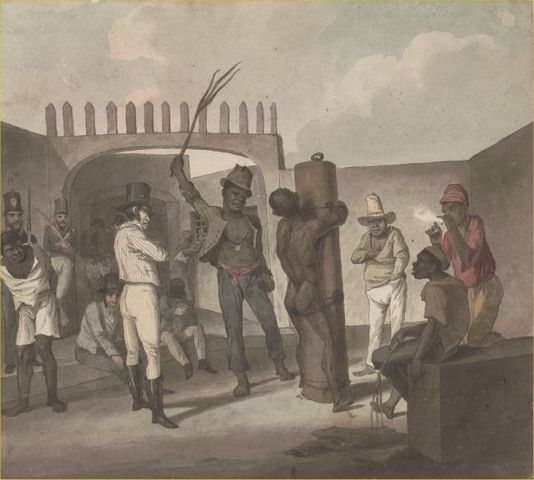
File:Punishing negroes at Calabouco.jpg

| |
This is a file from the Wikimedia Commons. Information from its description page there is shown below.
Commons is a freely licensed media file repository. You can help. |
Summary
| DescriptionPunishing negroes at Calabouco.jpg |
English: Punishing negros at Cathabouco (i.e. Calabouço, today place of Museu Histórico Nacional), in Rio de Janeiro, 1822. Watercolour; 23.6 x 26.3 cm.
Português do Brasil: Açoitamento de escravos na Ponta do Calabouço (atualmente local do Museu Histórico Nacional) no Rio de Janeiro, 1822. Aquarela; 23.6 x 26.3 cm
|
| Date | circa 1822 |
| Source | National Libray of Australia: http://nla.gov.au/nla.pic-an2822614-v |
| Author |
English: Augustus Earle (1793 - 1838)
Português: Augustus Earle (1793 - 1838)
|
Licensing
| Public domainPublic domainfalsefalse |
 |
According to the Brazilian Copyright Law (Lei 9.610 de 19 de fevereiro de 1998; See translation)
English | македонски | português | español | +/− |
|
| Public domainPublic domainfalsefalse |
 |
This media file is in the public domain in the United States. This applies to U.S. works where the copyright has expired, often because its first publication occurred prior to January 1, 1923. See this page for further explanation. |
|
|
|
This image might not be in the public domain outside of the United States; this especially applies in the countries and areas that do not apply the rule of the shorter term for US works, such as Canada, Mainland China (not Hong Kong or Macao), Germany, Mexico, and Switzerland. The creator and year of publication are essential information and must be provided. See Wikipedia:Public domain and Wikipedia:Copyrights for more details. |
The official position taken by the Wikimedia Foundation is that "faithful reproductions of two-dimensional public domain works of art are public domain, and that claims to the contrary represent an assault on the very concept of a public domain". For details, see Commons:When to use the PD-Art tag. {{ PD-Art}} template without parameter: please specify why the underlying work is public domain in both the source country and the United States
(Usage: {{PD-Art|1=|deathyear=|country=|date=}}, where parameter #1 can be PD-old-auto, PD-old-auto-1923, PD-old-100 or similar) |
|||||
File usage
Background information
You can learn about nearly 6,000 different topics on Schools Wikipedia. SOS Children works in 133 countries and territories across the globe, helps more than 62,000 children, and reaches over 2 million people in total. Go to http://www.soschildrensvillages.org.uk/sponsor-a-child to sponsor a child.
